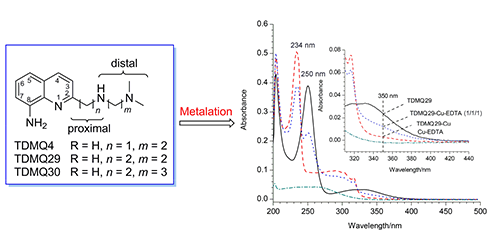| [1] Telpoukhovskaia, M. A.; Orvig, C. Chem. Soc. Rev. 2013, 42, 1836.
[2] Gaggelli, E.; Kozlowski, H.; Valensin, D.; Valensin, G. Chem. Rev. 2006, 106, 1995.
[3] Zhang, W.; Huang, D.; Huang, M.; Huang, J.; Wang, D.; Liu, X.; Nguyen, M.; Vendier, L.; Mazères, S.; Robert, A.; Liu, Y.; Meunier, B. ChemMedChem. 2018, 13, 684.
[4] Robert, A.; Liu, Y.; Nguyen, M.; Meunie, B. Acc. Chem. Res. 2015, 48(5), 1332.
[5] Nguyen, M.; Rechignat, L.; Robert, A.; Meunier, B. ChemistryOpen 2015, 4, 27.
[6] Bolea, I.; Gella, A.; Unzeta, M. J. Neural Transm. 2013, 120, 893.
[7] Cummings, J. L.; Travis, M.; Zhong, K. Alzheimer's Res. Ther. 2014, 6, 37.
[8] Scarpini, E.; Scheltens, P.; Feldman, H. Lancet Neurol. 2003, 2, 539.
[9] Nguyen, M.; Huang, M.; Liu, Y.; Meunier, B.; Robert, A. C. R. Chim. 2017, 20, 987.
[10] Viles, J. H. Coord. Chem. Rev. 2012, 256, 2271.
[11] Arena, G.; Pappalardo, G.; Sovago, I.; Rizzarelli, E. Coord. Chem. Rev. 2012, 256, 3.
[12] Migliorini, C.; Porciatti, E.; Luczkowski, M.; Valensin, D. Coord. Chem. Rev. 2012, 256, 352.
[13] Drew, S. C.; Barnham, K. J. Acc. Chem. Res. 2011, 44, 1146.
[14] Crapper, D. R.; Dalton, A. J.; Kruck, T. P.; Bell, M. Y.; Smith, W. L.; Kalow, W.; Andrews, D. F. Lancet 2011, 337, 1304.
[15] Ritchie, C. W.; Bush, A. I.; Mackinnon, A.; Macfarlane, S.; Mastwyk, M.; MacGregor, L.; Kiers, L.; Cherny, R.; Li, Q. X.; Tammer, A.; Carrington, D.; Mavros, C.; Volitakis, I.; Xilinas, M.; Ames, D.; Davis, S.; Volitakis, I.; Xilinas, M.; Ames, D.; Davis, S.; Beyreuther, K.; Tanzi, R. E.; Masters, C. L. Arch. Neurol. (Chicago) 2003, 60, 1685.
[16] Adlard, P. A.; Cherny, R. A.; Finkelstein, D. I.; Gautier, E.; Robb, E.; Cortes, M.; Volitakis, I.; Liu, X.; Smith, J. P.; Perez, K.; Laughton, K.; Li, Q. X.; Charman, S. A.; Nicolazzo, J. A.; Wilkins, S.; Deleva, K.; Lynch, T.; Kok, G.; Ritchie, C. W.; Tanzi, R. E.; Cappai, R.; Masters, C. L.; Barnham, K. J.; Bush, A. I. Neuron 2008, 59, 43.
[17] Bareggi, S. R.; Cornelli, U. CNS Neurosci. Ther. 2012, 18, 41.
[18] Cherny, R. A.; Atwood. C. S.; Xilinas, M. E.; Gray, D. N.; Jones, W. D.; McLean, C. A.; Barnham, K. J.; Volitakis, I.; Fraser, F. W.; Kim, Y.; Huang, X.; Goldstein, L. E.; Moir, R. D.; Lim, J. T.; Beyreuther, K.; Zheng, H.; Tanzi, R. E.; Masters, C. L.; Bush, A. I. Neuron 2001, 30, 665.
[19] Ceccom, J.; Cosledan, F.; Halley, H.; Frances, B.; Lassalle, J. M.; Meunier, B. Plos One 2012, 7, e43105.
[20] Ngyyen. M.; Robert, A.; Sournia-Saquet, A.; Vendier, L.; Meunier. B. Chem.-Eur. J. 2014, 20, 6771.
[21] Zhang, W.; Liu, Y.; Hureau, C.; Robert, A.; Meunier B. Chem.-Eur. J. 2018, 24, 7825.
[22] Zhang, W.; Huang, M.; Bijani, C.; Liu, Y.; Robert, A.; Meunier, B. C. R. Chim. 2018, 21, 745. |
